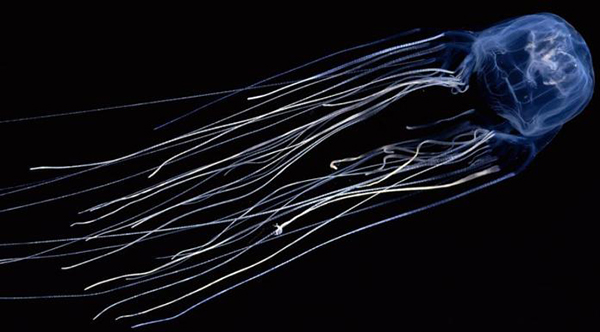
|
Search JoyZine with Google Site Search! |
Australian Box Jellyfish Chironex Fleckeri
Box jellyfish most visibly differ from the Scyphozoan jellyfish in that they are umbrella shaped, rather than domed or crown-shaped. The underside of the umbrella includes a flap, or velarium, concentrating and increasing the flow of water expelled from the umbrella. As a result, box jellyfish can move more rapidly than other jellyfish. In fact, speeds of up to six meters per minute have been recorded. The box jellyfish's nervous system is also more developed than that of many other jellyfish. Notably, they possess a nerve ring around the base of the umbrella that coordinates their pulsing movements, a feature found elsewhere only in the crown jellyfish. Box jellyfish are unique among jellyfish in the possession of true eyes, complete with retinas, corneas and lenses. Their eyes are located on each of the four sides of their bell in clusters called rhopalia; they therefore have 24 eyes. A box jellyfish has the closest thing a known jellyfish has to a brain. Box jellyfish also display complex, probably visually guided behaviors such as obstacle avoidance and fast directional swimming. They are pale blue and transparent in color and get their name from the cube-like shape of their bell. Up to 15 tentacles grow from each corner of the bell and can reach 3m in length. Each tentacle has about 5,000 stinging cells, which are triggered not by touch but by the presence of a chemical on the outer layer of its prey. The box jellyfish actively hunts its prey, rather than drifting, as do true jellyfish. They are capable of achieving speeds of up to 1.8m/s. Each tentacle has about 500,000 cnidocytes, containing nematocysts, a harpoon-shaped microscopic mechanism that injects venom into the victim. The venom of cubozoans is distinct from that of scyphozoans, and it is used to catch prey (small fish and invertebrates, including shrimp and bait fish) and for defense from predators, which include the butterfish, batfish, rabbitfish, the blue swimmer crab, and various species of sea turtles (hawksbill turtle, flatback turtle). Sea turtles are apparently unaffected by the sting and eat box jellyfish. Their venom is considered to be among the most deadly in the world, containing toxins that attack the heart, nervous system, and skin cells. Stings of Chironex fleckeri have several very severe consequences, due to its cardiotoxic (effect on the heart), neurotoxic (damage to the nerves) and dermatonecrotic (effect on the skin) components. It is not uncommon for victims who have had extensive contact (three metres of tentacles touching the skin can be enough to be fatal) to experience cardiac arrest within minutes. It is so overpoweringly painful, human victims have been known to go into shock and drown or die of heart failure before even reaching shore. Survivors can experience considerable pain for weeks. The tentacles stick tightly to the skin and may continue to release venom if not treated correctly, and often have significant scarring where the tentacles made contact due to necrosis of the affected tissue. The severity of a sting depends on the size of the box jellyfish, the amount of tentacles involved, the size of the victim (children are obviously more vulnerable), but also on the sensitivity of the skin of the victim. The Australian box jellyfish is found in the tropical oceans around northern Australia. Their habitat extends as far south as Exmouth on the west coast, and Bustard Heads on the east coast (just north of Agnes Waters). Chironex fleckeri is also present in the waters of the Indo-Pacific region near Papua New Guinea, the Philippines and Vietnam. Their exact distribution hasn't been determined yet. Box Jellyfish like to hang around river mouths, estuaries and creeks, especially after rain. When the tide is rising they tend to move towards shallower waters. What they don't like are deep waters and rough seas. They are also absent over coral reefs, and over areas that have lots of seagrass or weed. In late summer the adult jellyfish spawn at the river mouths. The eggs, once fertilised, turn into tiny polyps that attach themselves to rocks where they develop until next spring. Spring sees the polyps turn into tiny jellyfish that are washed downstream with the summer rains. In December 2012, Angel Yanagihara of the University of Hawaii's Department of Tropical Medicine found the venom causes cells to become porous enough to allow potassium leakage, causing hyperkalemia, which can lead to cardiovascular collapse and death as quickly as within 2 to 5 minutes. C. fleckeri has caused at least 64 deaths since the first report in 1883, but even in this species most encounters appear to only result in mild envenoming. Most recent deaths in Australia have been in children, which is linked to their smaller body mass. As a result, many Australian beaches are enclosed in nets and have vinegar placed in prominent positions allowing for rapid first aid. Box jellyfish are known as the "suckerpunch" of the sea not only because their sting is rarely detected until the venom is injected, but also because they are almost transparent. In northern Australia, the highest risk period for the box jellyfish is between October and May, but stings and specimens have been reported all months of the year. Similarly, the highest risk conditions are those with calm water and a light, onshore breeze; however, stings and specimens have been reported in all conditions. |
